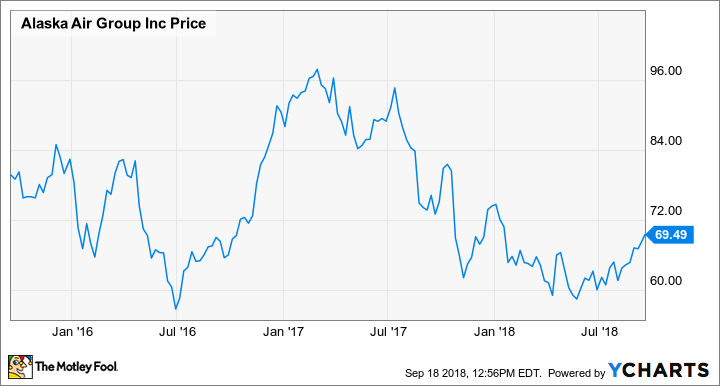Over the past two years, rising fuel prices and fare wars in parts of the U.S. have combined to put pressure on many airlines' profitability. Alaska Air (ALK -1.60%) has been one of the hardest-hit companies.
In 2015 and 2016, Alaska's adjusted pretax margin reached 24%, a phenomenal achievement. However, its pretax margin fell to 17% last year and is on track to plunge into single-digit territory in 2018. As a result, the stock fell from an all-time high of around $100 in early 2017 to a multiyear low of $57.53 just a few months ago.
Alaska Air Group Stock Performance. Data by YCharts.
Fortunately, there are growing signs that Alaska Air is on the brink of a turnaround. While the stock has already started to recover, there is plenty of upside left, even if the company's pretax margin never comes close to 20% again.
A small guidance improvement
On Monday, Alaska Air modestly increased its third-quarter revenue outlook in its monthly investor update. The carrier now expects revenue per available seat mile (RASM) to come in between 12.76 cents and 13.06 cents for the third quarter, down roughly 0% to 2% year over year.
The previous guidance range for RASM was 12.66 cents to 13.06 cents. Alaska attributed the guidance change to higher fares for last-minute bookings.
Alaska Airlines also improved its third-quarter unit cost forecast in the recent investor update. It now expects adjusted nonfuel unit costs to increase about 4.1% year over year this quarter, whereas it had previously projected a roughly 4.9% increase.
With fuel costs soaring, nonfuel costs rising, and unit revenue on track to be flat or down year over year, Alaska Airlines is still facing substantial margin pressure. But the trend is finally moving in the right direction. In the first half of 2018, RASM fell 3.4%.

Alaska Air's unit revenue trend is finally pointing in the right direction. Image source: Alaska Airlines.
Retrenching to focus on its strengths
Over the past few quarters, Alaska Airlines has rethought its growth plans in light of its subpar results. One key takeaway is that the carrier's late-2018 and 2019 growth will be centered on the Seattle region, where Alaska is the leading airline. By contrast, it grew rapidly in California in 2017 and early 2018, sparking a damaging fare war with Southwest Airlines (LUV -0.19%).
Alaska Airlines has already eliminated numerous underperforming routes from California this year and reduced capacity on others. A few more routes will be cut between now and early 2019.
Furthermore, Alaska is leasing all of its slots at New York's LaGuardia Airport and Washington, D.C.'s Reagan National Airport to Southwest Airlines for 10 years, starting next month. This will result in it ending its money-losing routes from Dallas to New York and Washington, D.C.
Meanwhile, Southwest Airlines will stop flying from San Francisco to Portland (a route that Alaska dominates) and to Orange County, California (a route that Alaska added last year). In other words, the competitive battle between the two low-fare carriers seems to be winding down.
Instead, Alaska Airlines plans to expand on its home turf. Earlier this month, it began flying between Seattle and Pittsburgh. A week before that, it announced plans to launch a Seattle–Columbus, Ohio, route in March 2019. No other carrier flies either route. Alaska is also set to begin operating 13 daily flights to eight destinations from Paine Field (about 20 miles north of Seattle in Everett, Washington) as soon as the FAA gives its final approval for commercial flights there.
Merger synergies and revenue enhancements coming on line
Lastly, merger synergies and other revenue-generating initiatives should drive a meaningful improvement in Alaska Airlines' RASM trend next year. First, Alaska expects to capture $130 million of incremental merger synergies next year, related to fully integrating the Virgin America operation during 2018.
Second, Alaska Airlines will soon begin selling "Saver" fares, its version of the basic economy tickets that have boosted its larger competitors' bottom lines. It has also implemented several fee and policy changes. In total, these moves are expected to boost annual revenue by $150 million going forward.
Alaska Air hasn't stabilized its profitability just yet. But between shifting capacity to the Seattle area -- where it is most dominant -- and capitalizing on merger synergies and other revenue initiatives, it is on track to return to strong profit growth in 2019. While the shares trade for almost 17 times projected 2018 earnings (which is pricey for an airline stock), the likelihood of substantial margin improvement in 2019 and beyond could push Alaska Air stock even higher.






